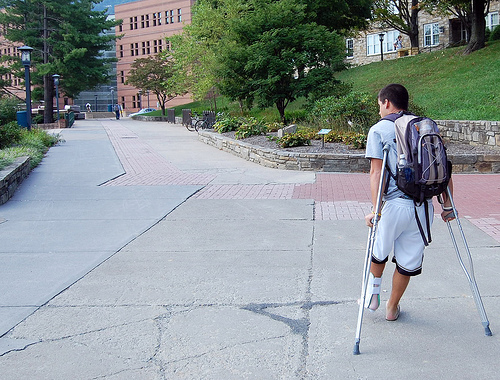Following on from Ankle Sprains and Strains Explained, Toby Cryne discusses key ankle˲ehabilitation˥xercises to aid recovery following an ankle injury.ʼ/em>
The ankle is one of the most highly impacted˪oints in the body. As the key connection˰oint between the foot and the leg, the area often comes under massive stresses from downward force. This is especially apparent during walking or running when the downward force of the body can be anywhere from 1.5 to 3.5 times the body weight (figures vary massively in different bodies of research).[1]

Put simply, a person weighing 150lbs could experience forces up to 525lbs of downward force on each leg with each stride. No surprise then that the ankle is one of the most easily injured areas of the lower limbs and that effective treatment of the hostile area is of paramount importance.˓o how does one properly rehabilitate an ankle sprain or strain? Letֳ find out.
If you havenִ done so already, take a look at our Ankle Sprain and Strain Explained article to find out more about the condition or read on for a brief overview and key ankle rehabilitation exercises.
A brief anatomy of the ankle
The ankle is constructed of three joints; the talocrural joint, the subtalar joint and the inferior tibio-fibular joint, all of which have different roles in the movement and stabilisation of the lower limbs.[2]
Each of these separate joints is connected by tissues known as ligaments which are exceptionally strong fibres constructed of collagen. These ligaments are responsible for movement of bones and stabilisation. Injuries to ligaments are known as sprains.

Of the three ligaments in the ankle; the deltoid ligament, lateral ligament and tibio-fibula ligament, the latter is the most commonly injured, counting for 90% of all ankle sprains.[3]
Where a bone and muscle join, a fiber known as a tendon is responsible for the connection. Tendons are similar in their make up to ligaments, both being fibrous tissues but an injury to a tendon is known as a strain.[4]
Still with me?
Common causes of ankle injuries
Sprain: The most common ankle sprain injury, known as a tibio-fibula ligament sprain occurs when the foot is rolled over, normally from a rapid change of direction which can cause a stretch, slight tear or complete rupture of the tissue acutely. If left untreated, these lesser injuries can develop into more serious conditions chronically over time.The different levels of a sprain are known to be a Grade I, II or III though as previously mentioned, a Grade I can develop into a Grade II or III if aggravated.
The below video shows in depth what occurs during this type of sprain:
The injury is exceptionally common in team sports such as football, basketball and contact sports.
Strain: A strain normally occurs through a chronic condition due to overuse from a repetitive action. Runners and cyclists are especially prone to injuries such as these due to the repetitive nature of their sport. Over time, small micro-tears appear in the tendons, a condition known as tendinitis which occurs due to a repeated over-stretch. If left untreated, these micro-tears can rupture or slip out of place. Acute injuries can also occur but are normally attributed to impact injuries from aˢreakage or dislocation.
See the Ankle Sprain and Strain Explained˦or more information.
Rehabilitation
Once you have ascertained what the condition you have is and have taken the appropriate measures to rest and recuperate (see the Ankle Sprain and Strain Explained˴o find out how), itֳ time to rehabilitate the area with a number of specified exercises.
Rehabilitation is exceptionally important regardless of the severity of the condition as if ignored, lower grades such as a Grade I sprain or strain can develop into the more serious Grade II or Grade III with the latter often requiring surgery to fix.
Both Isometric and Isotonic Exercises are incredibly useful in the rehabilitation of an ankle sprain or strain.
Isometric Exercises allow for strength increase and rehabilitation without moving the joint angle or muscle length.[5] These static exercises provide strength training for the supporting muscles and stabilisers such as the ligaments and tendons without moving an area that is currently weak.
Isotonic Exercises focus on the contraction of a muscle group in the targeted area. This type of exercise normally involves the movement of some type of force, whether that be the own body weight or an external force.
Isometric Exercises for ankle˲ehabilitation
Isometric Eversion allows you to strengthen the tissues of the ankle without working against resistance. An eversion exercise involves using a surface such as a chair leg or even the hand of another person to apply force against the joint in a sideways (lateral) motion. By pushing against an immovable object such as this, the stabilisation muscles, tendons and ligaments of the joint will increase in strength without irritating the affected area. Hold for three seconds, rest for five and repeat in sets of ten.
See the below video for more examples of Isometric Exercises:
Isotonic Exercises for ankle˲ehabilitation
When the area is completely pain free, isotonic exercises such as Resisted Eccentric Inversion using a PhysioRoom.com Resistance Band can be performed by using the resistance band to create resistance against the joint. The following video is an example of how to perform this exercise:
Another important aspect in ankle rehabilitation˩nvolves working the entireˬeg and core to better coordinate the body during times of increased stress. A number of exercises such as the ones found in the below video will not only help you regain ankle strength, they will also help develop core strength and lower body balance.
Please note: Ankle rehabilitation˥xercises should ONLY be done once the ankle is able to bare weight comfortably and the range of motion is nearly back to normal.
Any comments?
Have you had an ankle injury? Got a better recovery method? Comment on our social media pages and let us know!
[1] http://hypertextbook.com/facts/1999/SaraBirnbaum.shtml
[2] http://www.sportsinjuryclinic.net/anatomy/ankle-anatomy
[3] http://www.physioroom.com/info/blog/ankle-sprain-and-strain/
[4] http://www.nlm.nih.gov/medlineplus/ency/imagepages/19089.htm
[5] http://en.wikipedia.org/wiki/Isometric_exercise


